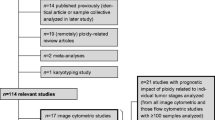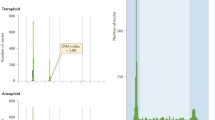Abstract
The heterogeneity in the DNA content was analysed in multiple biopsies from the surgical specimens in 77 cases of colonic and 46 cases of rectal adenocarcinomas. Frozen and unfixed tumour tissue was analysed with the flow cytometric technique. A total of 78/123 (63%) of all tumours displayed aneuploid stemlines in one or more pieces of tumour tissue; 45 were homogeneously aneuploid and 33 were heterogeneous, presenting both aneuploid and near-diploid samples. The remaining 45 tumours were homogeneously near-diploid. The heterogeneity in ploidy tended to be slightly higher if ten as compared with four samples from each tumour were analysed. Ploidy correlated to localization in the bowel and gender, but not to age, histopathological tumour stage, tumour differentiation or to the resectability rate for cure. The mean value of the S-phase fraction was 17% (range 7–31%) in the near-diploid and 14% (range 8–20%) in the aneuploid tumours. The range of the intratumoural variation was small for the DNA index (at most 5%) and high for the S-phase fraction (19% for neardiploid and 24% for aneuploid tumour pieces). Neither the mean value nor the heterogeneity in the DNA index and in the S-phase fraction displayed any correlation with the studied characteristics. In conclusion, the ploidy and the S-phase fraction varied considerably both within and between the tumours. As a consequence, multiple sampling is mandatory for a correct classification of colorectal adenocarcinomas based on the DNA content.
Résumé
L'hétérogénéité en DNA a été analysée sur de multiples biopsies provenant de spécimens chirurgicaux de 77 cas de cancers du colon et de 46 cas d'adénocarcinomes rectaux. Le tissu tumoral congelé et non fixé fut analysé par la technique du flux cytométrique. 78 des 123 tumeurs (63%) montraient une aneuploidie sur un ou plusieurs morceaux de tissu tumoral. 45 étaient aneuploides de façon homogène et 33 de façon hétérogène avec des échantillons aneuploides ou presque diploide. Les 45 tumeurs restantes étaient presque diploides de façon homogène. La tendance à l'hétérogénéité de la ploidie avait tendance à être légèrement plus élevée lorsque 10 échantillons plutôt que 4 de chaque tumeur étaient analysés. La ploidie était correlée avec la localisation dans l'intestin et le sexe mais non avec l'âge le stade histopathologique de la tumeur, la différenciation tumorale ou le taux de réséquabilité. La valeur moyenne de la fraction S-phase était de 17% (7–31%) dans les tumeurs presque diploides et 14% (8–20%) dans les tumeurs aneuploides. L'étendue de la variation intratumorale était petite pour l'index de DNA (5% au plus) et élevée pour la fraction S-Phase (19%) pour les tumeurs presque diploides et 24% pour les pièces des tumeurs aneuploides. Ni la valeur moyenne ni l'hétérogénéité dans l'index de DNA et de la fraction S-phase ne montraient de corrélation avec les caractéristiques étudiées. En conclustion la ploidie et la fraction S-phase varient considérablement à la fois dans la même tumeur et entre les tumeurs. Par voie de conséquence, de multiples échantillons doivent obligatoirement être demandés pour une classification correcte des adénocarcinomes colorectaux basés sur le contenu en DNA.
Similar content being viewed by others
References
Sasaki K, Hashimoto T, Kawachino K, Takahashi M (1988) Intratumoral regional differences in DNA ploidy of gastrointestinal carcinomas. Cancer 62:2569–2575
Büchner T, Hiddeman W, Wörmann B, Kleinemeier B, Schumann J, Göhde W, Ritter J, Müller K-M, von Bassewitz DB, Roessner A, Grundmann E (1985) Differential pattern of DNA-aneuploidy in human malignancies. Path Res Pract 179:310–317
Tribukait B (1984) Clinical DNA flow cytometry. Med Oncol & Tumor Pharmacother 1:211–218
Armitage NC, Robins RA, Evans DF, Turner DR, Baldwin RW, Hardcastle JD (1985) The influence of tumour cell DNA abnormalities on survival in colorectal cancer. Br J Surg 72:828–830
Kokal WA, Gardine RL, Sheibani K, Morris PL, Prager E, Zak IW, Terz JJ (1989) Tumor DNA content in resectable, primary colorectal carcinoma. Ann Surg 209:188–193
Scott NA, Wieand HS, Moertel CG, Cha SS, Beart RW, Lieber MM (1987) Colorectal cancer. Dukes' stage, tumor site, preoperative plasma CEA level, and patient prognosis related to tumor DNA ploidy pattern. Arch Surg 122:1375–1379
Scott NA, Rainwater LM, Wiand HS, Weiland LH, Pemberton JH, Beart RW Jr, Lieber MM (1987) The relative prognostic value of flow cytometric DNA analysis and conventional clinico-pathologic criteria in patients with operable rectal carcinoma. Dis Colon Rectum 30:513–520
Suzuki H, Matsumoto K, Masuda T, Koike H (1988) DNA ploidy of colorectal carcinoma. Correlation with conventional prognostic variables. J Clin Gastroenterol 10:176–178
Kokal W, Sheibani K, Terz J, Harada JR (1986) Tumor DNA content in the prognosis of colorectal carcinoma. JAMA 255:3123–3127
Quirke P, Dixon MF, Clayden AD, Durdey P, Dyson JED, Williams NS, Bird CC (1987) Prognostic significance of DNA aneuploidy and cell proliferation in rectal adenocarcinomas. Journal of Pathology 151:285–291
Streffer C, van Beuningen D, Gross E, Schabronath J, Eigler F-W, Rebmann A (1986) Predictive assays for the therapy of rectum carcinoma. Radiotherapy and Oncology 5:303–310
Jass JR, Mukawa K, Goh HS, Love SB, Cappelaro D (1989) Clinical importance of DNA content in rectal cancer measured by flow cytometry. J Clin Pathol 42:254–259
Jones DJ, Moore M, Schofield PF (1988) Prognostic significance of DNA ploidy in colorectal cancer: a prospective flow cytometric study. Br J Surg 75:28–33
Scivetti P, Danova M, Riccardi A, Fiocca P, Mazzini G (1989) Prognostic significance of DNA content in large bowel carcinoma: a retrospective flow cytometric study. Cancer Letters 46:213–219
Schutte B, Reynders MMJ, Wiggers T, Arends JW, Volovics L, Bosman FT, Blijham GH (1987) Retrospective analysis of the prognostic significance of DNA content and proliferative activity in large bowel carcinoma. Cancer Research 47:5494–5496
Rognum TO, Thorud E, Lund E (1987) Survival of large bowel carcinoma patients with different DNA ploidy. Br J Cancer 56:663–636
Wolley RC, Schreiber K, Koss LG, Karas M, Sherman A (1982) DNA distribution in human colon carcinomas and its relationship to clinical behavior. JNCI 69:15–22
Halvorsen TB, Johannesen E (1990) DNA ploidy, tumour site, and prognosis in colorectal cancer. Scand J Gastroenterol 25:141–148
Robey-Cafferty SS, El-Naggar AK, Grignon DI, Cleary KR, Ro JY (1990) Histologic parameters and DNA ploidy as predictors of survival in stage B adenocarcinoma of colon and rectum. Modern Pathology 3:261–266
Giaretti W, Sciallero S, Bruno S, Geido E, Aste H, Di Vinci A, d'Amore ESG (1989) DNA flow cytometry of endoscopically examined colorectal adenocarcinomas. Path Res Pract 185:589–593
Heimann TM, Miller F, Martinelli G, Mester J, Kurtz RJ, Szporn A, Fasy T (1990) Significance of DNA content abnormalities in small rectal cancers. Am J Surg 159:199–203
Finan PJ, Quirke P, Dixon MF, Dyson JED, Giles GR, Bird CC (1986) Is DNA aneuploidy a good prognostic indicator in patients with advanced colorectal cancer? Br J Cancer 54:327–330
Goh HS, Jass JR, Atkin WS, Cuzick J, Northover JMA (1987) Value of flow cytometric determination of ploidy as a guide to prognosis in operable rectal cancer: a multivariate analysis. Int J Colorect Dis 2:17–21
Melamed MR, Enker WE, Banner P, Janov AJ, Kessler G, Darzynkiewicz Z (1986) Flow cytometry of colorectal carcinoma with three-year follow-up. Dis Colon Rectum 29:184–186
Bauer KD, Lincoln ST, Vera-Roman JM, Wallemark CB, Chmiel JS, Madurski ML, Murad T, Scarpelli DG (1987) I. Prognostic implications of proliferative activity and DNA aneuploidy in colonic adenocarcinomas. Laboratory Investigation 57:329–335
Hiddemann W, von Bassewitz DB, Kleinemeier H-J, Schulte-Brochterbeck E, Hauss J, Lingemann B, Büchner T, Grundmann E (1986) DNA stemline heterogeneity in colorectal cancer. Cancer 58:258–263
Tribukait B, Hammarberg C, Rubio C (1983) Ploidy and proliferation patterns in colorectal adenocarcinomas related to Dukes' classification and to histopathological differentiation. Acta Path Microbiol Immunol Scand Sect A 91:89–95
Emdin SO, Stenling R, Roos G (1987) Prognostic value of DNA content in colorectal carcinoma. A flow cytometric study with some methodologic aspects. Cancer 60:1282–1287
Temple WJ, Sugarbaker EV, Thornthwaite JT, Hensley GT, Ketcham AS (1980) Correlation of cell cycle analysis with Dukes' staging in colon cancer patients. Journal of Surgical Research 28:314–318
Kuori M, Laasonen A, Mecklin J-P, Järvinen H, Franssila K, Pyrhönen S (1990) Diploid predominance in hereditary nonpolyposis colorectal carcinoma evaluated by flow cytometry. Cancer 65:1825–1829
Quirke P, Dyson JED, Dixon MF, Bird CC, Joslin CAF (1985) Heterogeneity of colorectal adenocarcinomas evaluated by flow cytometry and histopathology. Br J Cancer 51:99–106
Petersen SE, Lorentzen M, Bichel P (1980) A mosaic subpopulation structure of human colorectal carcinomas demonstrated by flow cytometry. Flow Cytometry IV:412–416
Jones DJ, Zaloudik J, James RD, Haboubi N, Moore M, Schofield PF (1989) Predicting local recurrence of carcinoma of the rectum after preoperative radiotherapy and surgery. Br J Surg 76:1172–1175
Banner BF, Tomas-de la Vega JE, Roseman DL, Coon JS (1985) Should flow cytometric DNA analysis precede definitive surgery for colon carcinoma? Ann Surg 202:740–744
Daver A, Bocquillon PG, Pagé M, Dalifard I, Chassevent A, Litas P, Cellier P, Bertrand G, Larra F, George P, Chabrun B, Ronceray J, Delaby J, Bressollette M, Roques JF, Barthe JP (1987) Flow cytometric studies of colorectal tumors using fine needle aspiration. Anticancer Research 7:531–534
Taylor I, Machin D, Mullee M, Trotter G, Cooke T, West C (1985) A randomized controlled trial of adjuvant portal vein cytotoxic perfusion in colorectal cancer. Br J Surg 72:359–363
Pahlman L, Glimelius B (1990) Radiotherapy additional to surgery in the management of primary rectal carcinoma. Acta Chir Scand 156:475–485
Ragaz J, Baird R, Rebbeck P, Goldie J, Coldman A, Spinelli J (1985) Neoadjuvant (preoperative) chemotherapy for breast cancer. Cancer 56:719–724
Vindelöv LL, Christensen IJ, Nissen NI (1983) A detergenttrypsin method for the preparation of nuclei for flow cytometric DNA analysis. Cytometry 3:323–327
Vindelöv LL, Christensen IJ, Nissen NI (1983) Standardization of high-resolution flow cytometric DNA analysis by the simultaneous use of chicken and trout red blood cells as internal reference standards. Cytometry 3:328–331
Sano T, Remvikos Y, Salmon RJ (1988) Cytométrie en flux. Application à l'étude du contenu cellulaire en ADN des tumeurs colorectales. Gastroenterol Clin Biol 12:629–636
Hiddemann W, Schumann J, Andreeff M, Barlogie B, Herman CJ, Leif RC, Mayall BH, Murphy RF, Sandberg AA (1984) Convention of nomenclature for DNA cytometry. Cytometry 5:445–446
Baisch H, Göhde W, Linden WA (1975) Analysis of PCP-data to determine the fraction of cells in the various phases of cell cycle. Rad and Environm Biophys 12:31–39
Goh HS, Jass JR (1986) DNA content and the adenoma-carcinoma sequence in the colorectum. J Clin Pathol 39:387–392
Hood DL, Petras RE, Edinger M, Fazio V, Tubbs RR (1990) Deoxyribonucleic acid ploidy and cell cycle analysis of colorectal carcinoma by flow cytometry. Am J Clin Pathol 93:615–620
Fowler JF (1989) The linear-quadratic formula and progress in fractionated radiotherapy. The British Journal of Radiology 62:679–694
Author information
Authors and Affiliations
Rights and permissions
About this article
Cite this article
Lindmark, G., Glimelius, B., Påhlman, L. et al. Heterogeneity in ploidy and S-phase fraction in colorectal adenocarcinomas. Int J Colorect Dis 6, 115–120 (1991). https://doi.org/10.1007/BF00300207
Accepted:
Issue Date:
DOI: https://doi.org/10.1007/BF00300207




